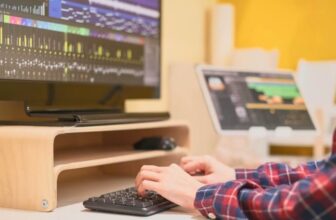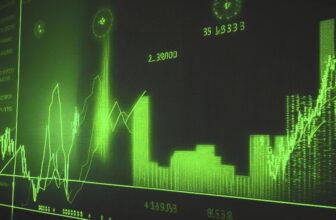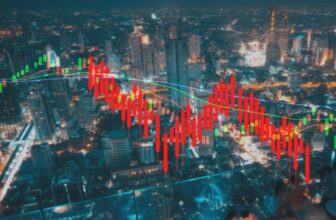
Embark on a journey into the world of forex trading! Curious about the learning curve? Join us as we explore the duration and key factors influencing the time it takes to master the intricate art of forex trading.
Learning forex trading requires a level of commitment and dedication. The time it takes to learn forex trading varies depending on individual factors such as the level of commitment, available time, experience, and natural ability. On average, it takes around one year to learn how to trade forex, ranging from 6 to 24 months.
Key Takeaways:
- Learning forex trading takes time, effort, and commitment.
- It generally takes around one year to become proficient in forex trading.
- The learning process involves understanding the basics, practicing trading, and staying updated on market trends.
- Investing in a forex education program can accelerate the learning process.
- Continuous learning and discipline are key to becoming a successful forex trader.
How Long Does It Take to Learn Forex?
Mastering forex trading involves navigating a substantial learning curve. On average, it takes approximately a year to grasp the fundamentals, with a range of 6 to 24 months. This timeline hinges on the individual’s ability to absorb the complexities of trading. People learn at different paces, with some acquiring the basics within a few weeks while others may take several months. Achieving mastery, however, often extends into years. This underscores the need for unwavering patience and dedication in the learning process.
While the learning process is inherently time-intensive, attendees of forex courses, avid readers of trading literature, and those who diligently practice on demo accounts can expedite their journey. However, it’s crucial to acknowledge that success demands consistent and substantial time investment.
Understanding the Forex Market
Decentralised Marketplace
Forex trading operates within a decentralised marketplace where global currencies are exchanged. To trade successfully, one must comprehend currency pairs, identify market drivers, understand market trends such as bull and bear markets, and grasp the influence of central banks on currency values.
Ten Thousand Hours Rule
Success in forex trading aligns with the ten thousand hours rule. This principle, popularized by Malcolm Gladwell, posits that expertise in any field requires approximately ten thousand hours of practice. Thus, continual learning and staying abreast of market changes are critical for sustained success.
Exploring the Ten Thousand Hours Rule in Forex Trading
The concept of the Ten Thousand Hours Rule, popularized by author Malcolm Gladwell in his book “Outliers,” posits that it takes approximately ten thousand hours of deliberate practice to achieve mastery in any given field. When applied to forex trading, this rule underscores the necessity for extensive learning and practice before one can truly excel in navigating the complexities of the market.
For forex trading, the rule implies that a trader needs to invest a substantial amount of time in education, analysis, and practical application. This goes beyond a mere understanding of the basics and involves continuous learning, adapting to market changes, and honing one’s skills through consistent practice.
For aspiring forex traders, this rule translates into a considerable time commitment. It’s not just about clocking in hours; it’s about purposeful and focused practice. Learning the intricacies of currency pairs, technical analysis, risk management, and understanding market psychology all contribute to the cumulative hours required to reach proficiency.
Examples of the Ten Thousand Hours Rule in Trading
- Technical Analysis: Achieving mastery in technical analysis involves studying chart patterns, indicators, and price action. Traders need to spend countless hours analysing historical data, identifying trends, and understanding the nuances of different chart formations.
- Risk Management Expertise: Learning to manage risks effectively is a crucial aspect of forex trading. Traders must devote significant time to understanding risk-reward ratios, setting stop-loss orders, and implementing strategies to protect their capital from substantial losses.
- Market Psychology Understanding: The emotional aspect of trading is often underestimated. Traders need to dedicate time to understanding their own psychological responses to wins and losses and develop strategies to maintain discipline during challenging market conditions.
“The Ten Thousand Hours Rule” serves as a reminder that success in forex trading is not an overnight achievement. It emphasizes the importance of consistent effort, continuous learning, and a commitment to improvement. By embracing this principle, traders can navigate the learning curve with realistic expectations, ultimately positioning themselves for sustained success in the dynamic world of forex.
Mastering Forex Trading: Key Strategies
Discard Get-Rich-Quick Mentality
Forex trading is not a shortcut to quick wealth. Success demands a consistent focus on trading and risk management strategies. Embracing a long-term perspective is vital for sustained profitability.
Comprehensive Study
The learning process typically extends beyond 12 months, even with intensive study. Utilizing a variety of resources, including books, online courses, and forums, contributes to a well-rounded understanding of forex trading.
Join Funded Forex Trader Program
For a structured learning experience, aspiring traders can consider joining a funded forex trader program. These programs offer coaching, demo accounts for practical application, live trading capital, and access to a quality trading platform.
Understand Trading Psychology
An essential aspect of mastering forex trading involves understanding personal trading psychology. Keeping a trading journal aids in tracking thought patterns and behaviours, facilitating better decision-making and risk management.
Patience is Key
Success in forex trading is a gradual process that demands time, patience, and unwavering dedication. It’s essential not to get discouraged by immediate results, as consistent effort yields long-term success.
Leverage Trading Communities
Active engagement with trading communities provides invaluable support, advice, and exposure to diverse trading strategies. Platforms such as Twitter or trading Discord servers offer opportunities for collaboration and learning from experienced traders.
Advantages of Forex Trading
Forex trading offers numerous advantages that make it an appealing venture for many individuals. One of the main attractions is the potential for profitable returns when done correctly. Forex trading provides opportunities for leveraging, which means that traders can control larger positions with relatively smaller amounts of capital. This enables them to magnify potential profits, increasing the potential for higher returns.
Another advantage of forex trading is the global nature of the market. With a daily trading volume of over $6 trillion, the forex market is the largest financial market worldwide. This vast size translates into ample opportunities for profit, as there are always fluctuations in currency exchange rates that traders can exploit. Additionally, the forex market operates 24 hours a day, five days a week, giving traders the flexibility to engage in trading activities at their convenience.
Furthermore, the forex market is known for its high liquidity. Liquidity refers to the ease with which an asset can be bought or sold without causing significant price movements. The forex market’s high liquidity ensures that there is always a buyer or seller available, allowing traders to enter and exit positions swiftly without worrying about market impact. This liquidity also means that traders can trade larger volumes without experiencing substantial slippage, which can occur when executing trades in illiquid markets.
In summary, forex trading offers several advantages that make it an attractive option for individuals looking to participate in financial markets. The potential for profitable returns, the global nature of the market, its 24/7 availability, and high liquidity all contribute to the appeal of forex trading.
Factors Affecting Forex Learning Time
When it comes to learning forex trading, several factors can influence the time it takes to become proficient in the market. Understanding these factors can help aspiring traders set realistic expectations and tailor their approach to learning forex.
Level of Commitment
One of the main factors that affect forex learning time is the level of commitment. Learning forex trading requires dedication and consistent effort. Those who are fully committed to their education and are willing to put in the necessary time and energy are likely to progress faster.
Available Time
The amount of time available to dedicate to learning also plays a significant role in the learning period. Traders with more free time can immerse themselves in the study of forex trading, practice trading strategies, and review market trends more frequently, potentially accelerating their learning curve.
Experience and Natural Ability
Previous experience in trading can have an impact on the time it takes to learn forex. Traders who have already developed a solid foundation in financial markets may find it easier to grasp forex concepts and techniques. Additionally, natural ability, such as analytical skills and the ability to handle stress, can also influence how quickly one progresses in their forex education.
It’s important to note that everyone progresses at their own pace, and individual differences can significantly impact learning time. Some traders may grasp the intricacies of forex trading quickly, while others may require more time and practice. However, with dedication, continuous learning, and a disciplined approach, anyone can become proficient in forex trading.
| Factors Affecting Forex Learning Time | Level of Commitment | Available Time | Experience and Natural Ability |
|---|---|---|---|
| Impact | Crucial determinant | Significant influence | Variable impact |
| Description | Level of commitment plays a vital role in determining learning time. | The amount of time available to dedicate to learning affects the learning period. | Previous experience in trading and natural ability can impact the learning curve. |
Conclusion
Learning forex trading requires time, dedication, and effort. The duration of this learning process varies depending on individual factors, such as level of commitment, available time, experience, and natural ability. On average, it takes about one year to become proficient in forex trading, but the learning period can range from 6 to 24 months.
The learning process involves understanding the basics of forex trading, practicing trading strategies, and staying updated on market trends. While learning the basic technical analysis elements can be done in a few weeks, mastering risk management and psychology takes longer. It is important to have realistic expectations and not expect immediate success in this competitive market.
Investing in a forex education program can accelerate the learning process by providing structured guidance and resources. Continuous learning and staying disciplined are key to becoming a successful forex trader. Remember, forex trading requires continuous adaptation to market changes, and staying updated with the latest strategies and techniques.
FAQ
How long does it take to learn forex trading?
The time it takes to learn forex trading varies depending on individual factors such as level of commitment, available time, experience, and natural ability. On average, it takes around one year to become proficient in forex trading, but it can range from 6-24 months.
What skills are involved in forex trading?
Forex trading encompasses various skills including technical analysis, risk management, and psychology. Learning the basic technical analysis elements can be done in a few weeks, but mastering risk management and psychology takes longer.
What are the advantages of forex trading?
Forex trading offers several advantages that attract people to the market. It can be highly profitable if done correctly, thanks to leverage opportunities. The forex market is the largest in the world, providing ample opportunities for profit. It operates 24 hours a day, five days a week, allowing flexibility for trading. Additionally, the forex market has high liquidity, ensuring there is always activity and opportunity.
What factors affect the learning time for forex trading?
The learning time for forex trading is influenced by factors such as level of commitment, available time, experience, and natural ability. The level of commitment is crucial in determining learning time, as well as the amount of time available to dedicate to learning. Previous experience in trading can impact the learning curve, and natural ability can influence how quickly one grasps forex trading concepts. Additionally, everyone progresses at different rates, so individual differences play a role in learning time.
How can I accelerate my learning process in forex trading?
Investing in a forex education program can accelerate the learning process. These programs provide structured lessons and guidance from experienced traders. Additionally, continuous learning and staying disciplined are key to becoming a successful forex trader. It is important to have realistic expectations and not expect immediate success.

















